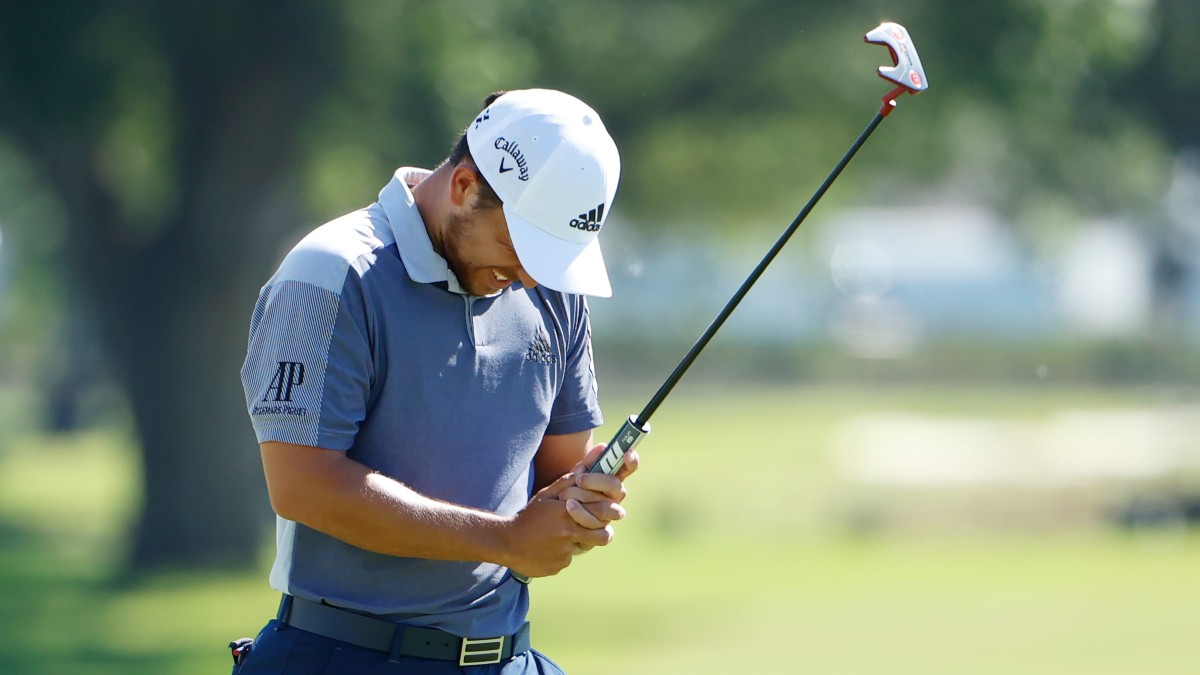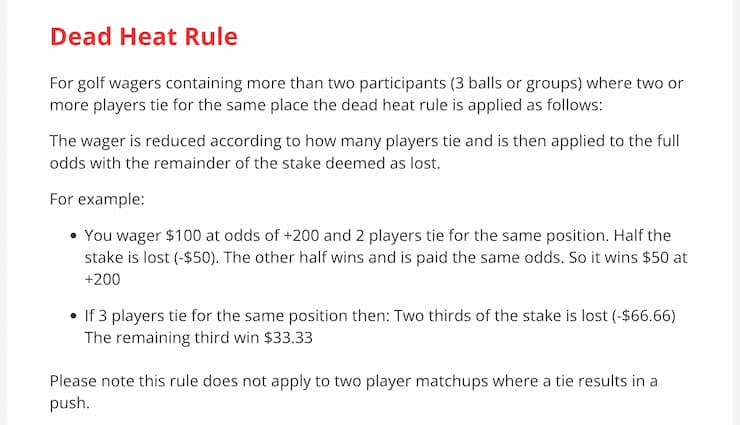What is dead heat rule in golf betting

In a DEAD HEAT, the stake money on a selection is divided by the number of runners involved in the dead heat. The what is dead heat rule in golf betting odds are then paid to the divided stake. It would be appropriate for your wagered amount to be returned and the winnings be divided among the number of players finishing in that. Dead Heat Rule applied to Golf Bets In Golf tournaments there is generally not a dead heat for the actual winner of a tournament, as extra holes are played. Dead heat rules mean that instead of your full bet paying out, your stake will be split based on how many players are tied. In this case, five.
Dead Heat Rules in Golf Betting, Explained: What Happens When Players Tie?
The horse who came away with the most wins in all heats was declared the victor. Dead heat rules delineate how winnings will be tabulated in the event of a tie. Understanding dead heat rules can be complicated. The easiest way to understand them is to know that in a dead heat, you essentially win part of your bet and lose part of your bet.
In races or tournaments that end in a dead heat, the stake would be divided by the number of racers in the tie multiplied by the odds at which the bet was placed. For example, in a dead heat where there was a tie between two winners, the stake would be divided in half. In a three-way tie, which is even more uncommon than a two-way tie, the stake would be divided into thirds — one-third In that case, most sportsbooks pay ties in full.
Sportsbooks may handle their dead heat rules in different ways. For example, instead of cutting the stake, some may cut the odds. For example, dead heats rarely happen in track and field races because of the exceptional photo-finish technology. Throughout history, horse racing has witnessed the most dead heats or two-way ties for first place.
Though three-way dead heats are extremely rare in horse racing, they have occurred. On November 3, , the Hotham Handicap ended in a triple heat in Melbourne, Australia — the first triple heat since photo finishes began in Australia in To see just how rarely dead heats occur, check out this global list of horse races ending in dead heats from April to May — only 57 in more than years.
Considering that hundreds of horse races are occurring on any one day in the U. However, in sports today, dead heats occur more often in golf, but not as a tie for first place. In a golf tournament, where there may be 80 competitors, three may finish in a tie for 5th place or 10th place. Dead heats are determined in these sports because multiple athletes jockeying for a position, making it possible for more than one person to finish in the same place.
Dead Heat Rules: Golf Golf matches never end in a dead heat for first place. If a tie occurs for first place, players generally play more holes to determine the winner. Instead, dead heats occur in golf when several players end with the same score — the top 5s, 10s, or 20s. What is dead heat rule in golf betting Dead heats can also happen in golf for first-round leader bets. In golf dead heats, winnings can depend on the number of players involved in a tie and the number of places offered.
Here is an example of a dead heat for 3rd, 5th, and 8th place in the Masters Tournament:. So, if you place a bet in golf that ends in a dead heat, how much will you get paid. Most sportsbooks will cut your stake by the number of golfers tied for the same position. Others may cut the odds , and in some cases, you could even lose money.
Try ZenSport for the best experience in sports betting, dead heat or not. Dead heat rules in horse racing are similar to those in golf. Most payouts are made by dividing the stake by the number of horses in a tie. Though dead heat payout rules vary from state to state, most of them pay win and place bets the same.
Payouts in a dead heat can be pretty straightforward if the stake is divided and the odds are kept the same. Based on the original odds of your bet, payouts are figured by dividing the stake the amount of your wager by the number of winners in the tie. Dead heats are determined in these sports because multiple athletes jockeying for a position, making it possible for more than one person to finish in the same place.
Dead Heat Rules: Golf Golf matches never end in a dead heat for first place.  If a tie occurs for first place, players generally play more holes to determine the winner. Instead, dead heats occur in golf when several players end with the same score — the top 5s, 10s, or 20s.
If a tie occurs for first place, players generally play more holes to determine the winner. Instead, dead heats occur in golf when several players end with the same score — the top 5s, 10s, or 20s.
Dead heats can also happen in golf for first-round leader bets. In golf dead heats, winnings can depend on the number of players involved in a tie and the number of places offered. Here is an example of a dead heat for 3rd, 5th, and 8th place in the Masters Tournament:. So, if you place a bet in golf that ends in a dead heat, how much will you get paid. Most sportsbooks will cut your stake by the number of golfers tied for the same position.
Others may cut the odds , and in some cases, you could even lose money. Try ZenSport for the best experience in sports betting, dead heat or not. Dead heat rules in horse racing are similar to those in golf. Most payouts are made by dividing the stake by the number of horses in a tie. Though dead heat payout rules vary from state to state, most of them pay win and place bets the same.
Payouts in a dead heat can be pretty straightforward if the stake is divided and the odds are kept the same. Based on the original odds of your bet, payouts are figured by dividing the stake the amount of your wager by the number of winners in the tie. A two-way dead heat would be divided in two, and three-way heat would be divided in three, etc.
In this tournament, two players tied for 2nd, three players tied for 4th, three players tied for 7th, and five players tied for 10th. In this case, dead heat rules would be applied, so that the total stake was divided by the number of players in a tie at normal odds. Payouts may be made differently depending on whether you are dealing with win markets or place markets. A payout for a win market with 2 runners that tied would be calculated as follows:.
In a win market with more that two tying runners :. Sportsbooks have systems in place, many that are automated, that allow them to move lines quickly — in just seconds. And this always gives sportsbooks an advantage. If you place wagers using a sportsbook, do your research and always stick with reputable sportsbooks.
Download the ZenSports app today and experience the fastest and easiest way to bet — right from your phone. Blog Home All Posts. Dead heats are rare, but they do happen. What Are Dead Heat Rules. Why Is it Called a Dead Heat. Dead heat rules involve two things: The stake The odds In races or tournaments that end in a dead heat, the stake would be divided by the number of racers in the tie multiplied by the odds at which the bet was placed.
Dead heats are uncommon, but they do happen. The frequency of dead heats is often dependent on: The type of sport; and The level of precision in the technology used For example, dead heats rarely happen in track and field races because of the exceptional photo-finish technology. The track receives its percentage.
Popular Pages
- Worldwinner coupons
- British open score
- Rule 4 golf betting
- Beta tau lambda alpha phi alpha charity golf torunament
- Cazoo open golf betting tips
- British open betting
- Pga memorial golf leaderboard
- Wm golf
- How does pari mutuel betting work in golf
- Jessica valero
- William hill betting golf
- The open odds 2023 golf
- Bovada golf bets
- Liv promotions leaderboard
- Favorites to win pga championship